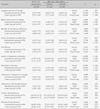Abstract
Purpose
This study was to estimate the effectiveness of an intervention program using the trans-theoretical model on the stages of change, the process of change, decisional balance, self-efficacy, the levels of medication adherence, and blood pressure difference.
Methods
A similar experiment was conducted using a nonequivalent control group pre- and post-test design. The study subjects were 108 hypertensive patients. The program was administered to the experimental group while educational materials were given to the control group. Descriptive analysis, 2-test, t-test, and repeated measures ANOVA were used with SPSS 17.0 to analyze collected data.
Results
After treatment with this program, the experimental group showed stage of change (χ2=52.917, p<.001), cognitive (F=13,528, p<.001), behavioral process of change (F=10.808, p<.001), benefits (F=5.569, p=.012), loss of medication adherence (F=15.661, p<.001), self-efficacy (F=5.407, p=.011), levels of medication adherence (F=51.442, p<.001).
Conclusion
There was a significant improvement in the experimental group who participated in the TTM medication adherence intervention program. Given that this intervention program motivated and stimulated hypertensive patients to adhere to the prescribed medications, the TTM medication adherence intervention program is expected to be an effective and practical intervention method for health improvement.
Figures and Tables
References
1. Ahn SY. Medication compliance of recently discharged elderly patients. Seoul: Seoul National University;1999. Unpublished master's thesis.
2. Boudreaux ED, Francis Jl, Carmack Taylor Cl, Scarinci LC, Brantley PJ. Changing multiple health behaviors: Smoking and exercise. Prev Med. 2003; 36(4):471–478.

3. Carbonari JP, DiClemente CC. Using transtheoretical model profiles to differentiate level of alcohol abstinence success. J Consult Clin Psychol. 2000; 68(5):810–817.
4. Chobanian AV, Bakris GL, Black HR, Cushman WC, Green LA, Izzo JL, et al. The seventh report of the joint national committee on prevention, detection, evaluation, and treatment of high blood pressure: The JNC 7 report. J Am Med Assoc. 2003; 290(2):197.

5. Cook NR, Cohen J, Hebert PR, Taylor JO, Hennekens CH. Implications of small reductions in diastolic blood pressure for primary prevention. Arch Intern Med. 1995; 155(7):701–709.

6. Guillot J, Kilpatrick M, Hebert E, Hollander D. Applying the transtheoretical model to exercise adherence in clinical settings. Am J Health Stud. 2004; 19(1):1–11.
7. Han KS. Relationship of blood pressure control with healthy lifestyle practice and medication adherence of hypertensive patients. Junju: Chonbuk National University;2009. Unpublished master's thesis.
8. Hong MY. A study on the medication compliance of the hypertension patients. Seoul: Seoul National University;1999. Unpublished master's thesis.
9. Johnson SS, Driskell MM, Johnson JL, Dyment SJ, Prochaska JM, Bourne L. Transtheoretical model intervention for adherence to lipid-lowering drugs. Dis Manag. 2006; 9:102–114.

10. Kim KE. Development and effect of a reducing alcohol intervention program for workers. Seoul: Yonsei University;2006. Unpublished doctoral dissertation.
11. Kim HJ. Development and evaluation of a medication adherence improvement program for older adults with hypertension. Seoul: Seoul National University;2009. Unpublished doctoral dissertation.
12. Kim YH. The effect of smoking cessation counseling program of public health center using transtheoretical model. Busan: Pusan National University;2007. Unpublished doctoral dissertation.
13. Kim YO. Medication compliance and depression in older hypertensive adults. Seoul: Chung-Ang University;2008. Unpublished master's thesis.
14. Korea Ministry of Health, Welfare and Family Affairs, & Korea
Center for Disease Control and Prevention. 2007 Korea national health and nutrition examination survey statistics: The 4th Korea national health and nutrition examination survey. Seoul: Author;2009.
15. Lee HJ. Factors affecting medication compliance of hypertensive patients. Cheonan: Dankook University;2002. Unpublished master's thesis.
16. Lee SG, Bae SS. The relationship between treatment intention and compliance in newly detected hypertensive patients. Korean J Prev Med. 2001; 34(4):417–426.
17. Lee YJ. The effects of TAI CHI exercise program using transtheoretical model applied to degressive arthritis patients. Seoul: Hanyang University;2008. Unpublished doctoral dissertation.
18. Lim JM. The study on the development of a smoking cessation counseling program and it's effect on adolescent smoking. Seoul: Sahmyook University;2002. Unpublished master's thesis.
19. Moon HJ. Factors related to antihypertensive medication adherence and blood pressure control among older adults. Seoul: Yonsei University;2008. Unpublished master's thesis.
20. Park JH. Antihypertensive drug medication adherence of national health insurance beneficiaries and its affecting factors in Korea. Seoul: Seoul National University;2006. Unpublished doctoral dissertation.
21. Pearlman DN, Rakowski W, Ehrich B. The information environment of women and mammography screening: Assessing reciprocity in social relationships. J Womens Health. 1997; 4(5):541–553.

22. Prochaska JO, DiClemente CC. Stage and process of self-change of smoking: Toward and integrative model of change. J Consult Clin Psychol. 1983; 51:390–395.
23. Prochaska JO, Velicer WF, DiClemente CC, Fava J. Measuring process of change: Applications to the cessation of smoking. J Consult Clin Psychol. 1988; 56(4):520–528.
24. Prochaska JO, Diclemente CC, Norcross JC. In search of how people change: Application to addictive behaviors. Am Psychol. 1992; 47(9):1102–1114.
25. Rudd P, Miller HN, Kaufman J, Kraemer HC, Bandura A, Greenwald G, et al. Nurse management for hypertension. Am J Hypertens. 2004; 17(10):921–927.
26. Statistics Korea. Annual report on the cause of death statistics: 2009 Annual report on the cause of death statistic. Seoul: Author;2010.
27. Sun GS. The effect of web-based osteoporosis prevention program on the osteoporosis knowledge, self efficacy, health belief, stage of change in female college students. Gwangju: Chonnam National University;2003. Unpublished doctoral dissertation.
28. Vasilaki EI, Hosier SG, Cox WM. The efficacy of motivational interviewing as a brief intervention for excessive drinking: A meta-analytic review. Alcohol Alcohol. 2006; 41(3):328–335.

29. Velicer WF, Diclemente CC, Rossi JS, Prochaska JO, Brandenburg N. A decisional balance measure for assessing and predicting smoking status. J Pers Soc Psychol. 1985; 48:1279–1289.
30. Willey C, Redding C, Stafford J, Garfield F, Geletko S, Flanigan T, et al. Stages of change for adherence with medication regimens of a measure. Clin Ther. 2000; 22(7):858–871.




 PDF
PDF ePub
ePub Citation
Citation Print
Print







 XML Download
XML Download